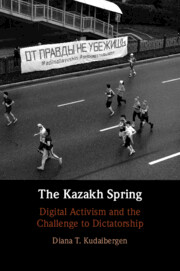Book contents
- The Kazakh Spring
- The Kazakh Spring
- Copyright page
- Dedication
- Contents
- Figures
- Tables
- Acknowledgements
- Introduction
- 1 What Is the Kazakh Spring?
- 2 Who Are Oyan, Qazaqstan?
- 3 Deconstructing Vlastʼ
- 4 Performing the State, Performing the Protest
- 5 Generation Q and Decolonizing Alash
- 6 The Public Square and the Body under Authoritarian Pressures
- 7 Queering the Public Sphere
- 8 Making Sense of the Bloody January 2022 Mass Protests
- Conclusions
- References
- Index
6 - The Public Square and the Body under Authoritarian Pressures
Published online by Cambridge University Press: 16 May 2024
- The Kazakh Spring
- The Kazakh Spring
- Copyright page
- Dedication
- Contents
- Figures
- Tables
- Acknowledgements
- Introduction
- 1 What Is the Kazakh Spring?
- 2 Who Are Oyan, Qazaqstan?
- 3 Deconstructing Vlastʼ
- 4 Performing the State, Performing the Protest
- 5 Generation Q and Decolonizing Alash
- 6 The Public Square and the Body under Authoritarian Pressures
- 7 Queering the Public Sphere
- 8 Making Sense of the Bloody January 2022 Mass Protests
- Conclusions
- References
- Index
Summary
This chapter provides an overview of the innovative protesting techniques of the Kazakh Spring and the Oyan, Qazaqstan movement. The interplay between the repressive law-enforcement agencies and the creative protesting techniques and narratives protestors had to find is at the heart of this chapter. I argue that the evolution of the protestors’ movements led to slow but consistent adaptation on the part of the police and secret police, and all those involved in the physical and emotional harassment of the protestors. Through interviews, I focus on how the body of the protestor and the public square become the two prime spaces for aggressive coercion and resistance. This pushes protestors to stage bodiless performances with anonymous posters and anonymous online activism, on the one hand. And on the other hand, it pushes law-enforcement officers to find aggravated techniques of torture. They came up with the kettling strategy, whereby protestors are trapped for hours in the heat or severe cold without access to basic amenities, water, food, or shelter. Other techniques of torture included kidnapping, intimidation, and even sexual violence.
- Type
- Chapter
- Information
- The Kazakh SpringDigital Activism and the Challenge to Dictatorship, pp. 194 - 219Publisher: Cambridge University PressPrint publication year: 2024

